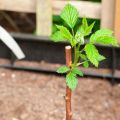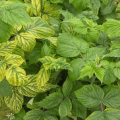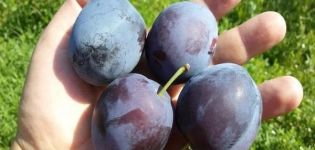How to quickly propagate remontant raspberries, methods and timing of harvesting cuttings
Repaired raspberries are characterized by long-term fruiting during the growing season. It is not surprising why many gardeners are wondering how to properly propagate remontant raspberries. When growing any agricultural crop, every summer resident wants to get as much harvest as possible. That is why such hybrids quickly became popular among gardeners.
When to harvest planting material
Before breeding raspberries, you should decide on the timing of harvesting planting material. The period when you need to harvest raspberries should be chosen based on the timing of planting. For propagation by cuttings, seedlings are harvested in spring. Most often, raspberries are bred in the spring, therefore, it is recommended to choose planting material at this time.
When planting in the fall, the preparation of seedlings begins in the summer. When propagating in summer, seedlings are also prepared in spring.
Methods and technology for reproduction of remontant raspberries
There are several ways to breed remontant raspberries. If you follow all the rules of agricultural technology when planting, you will be able to quickly grow raspberry bushes, which will bear fruit abundantly.
Nettle method
Repaired raspberries are propagated by the "nettle" method. This method is used in the spring. When raspberries start to sprout, they look more like nettles. When planting, the shoots should be at least 10 cm high and with two full leaves.

Planting raspberries using the "nettle" method:
- Shake off the soil from the base of the shoot.
- Cut off the shoot along with the white underground part of the stem (it can be 3-5 cm long).
- Cut bushes are treated with drugs that activate growth.
- For planting, prepare a loose substrate (mix peat and sand).
- To plant a seedling, the entire white underground part and part of the green shoot must remain underground.
- Water the bushes abundantly with warm water.
- Cover the bushes with bottles to create a greenhouse effect.
After a few weeks, the seedlings should give roots. As soon as they get stronger, the raspberries are transplanted to a permanent place on the street. Planting is done towards the end of June.
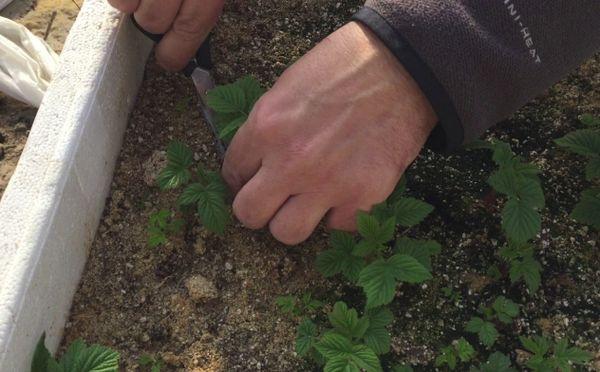
Green cuttings
Propagating remontant raspberries by cuttings is quite simple. For this method, take healthy young shoots without signs of disease and traces of insects. It is best to choose a cloudy day to prepare cuttings for planting.
Reproduction of varieties of remontant raspberries by green cuttings in summer:
- Cut green young shoots with a sharp pruner (it is recommended to cut it closer to the base of the rhizome).
- Place in water, adding a growth stimulant.
- After a while, roots should appear on the cuttings.
- When the roots are large enough, the cuttings are transplanted into fertile, moist soil.
With proper care, the stalk will very quickly begin to grow deciduous and begin to bear fruit. After planting in open ground, they are watered abundantly. Also, it will not be superfluous to introduce complex mineral fertilizers.
Rooting by woody cuttings
Lignified cuttings are planted in autumn, in September-October. Annual shoots, which have already become lignified, are used as planting material.
Cutting varieties of remontant raspberries in the fall:
- Cut the cuttings about 20 cm long.
- Remove all the leaves, new buds have already appeared on the cuttings, and the foliage will only take away nutrients.
- Dig up the soil, dig holes.
- Place the cuttings in the holes so that only two buds remain on the surface.
- Cover with spruce branches or agrofibre.
- In the fall, the shoots will take root, and in the spring they will begin to grow actively.

Also, reproduction by lignified cuttings is carried out in the spring. For this, the stems are cut in the same way as in the first method. Then they are placed in boxes with wet sand and left in the refrigerator. In March, the cuttings are rooted at home, and when the heat comes, they are planted.
Dividing the bush
Bush division is used most often in the cultivation of most crops. This method is suitable for plant propagation in the fall. The optimal time for transplanting is September-October, when the raspberries finish bearing fruit.
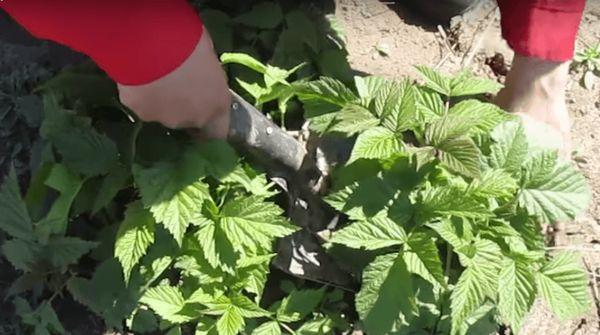
For reproduction by dividing the bush, 2-3-year-old bushes are suitable. The bush is cut into several parts with a sharp shovel and dug out. Then each part is transplanted to a new location. After planting, the soil around the raspberry is mulched so that it survives the winter frosts well and does not die.
Propagation by root cuttings from a mother bush
The easiest way to propagate remontant raspberries from the mother bush is. Root cuttings are suitable for propagation in this way. The root cutting is a part of the rhizome with a lateral branch. For reproduction, roots with a thickness of more than 2 mm are used.
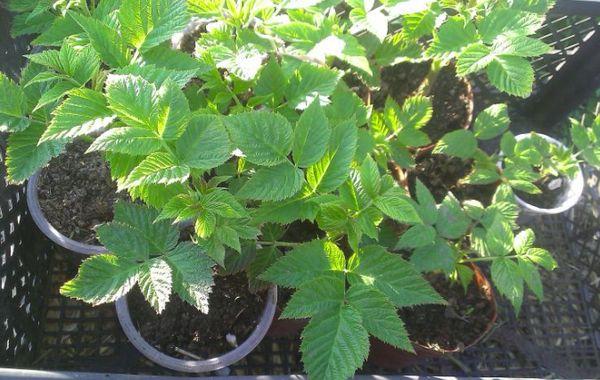
Root cuttings are separated from the mother bush in spring:
- Cuttings are cut from the mother bush after it is covered with leaves.
- Then they are planted in holes about 5 cm deep.
- After that, the holes are covered with soil, lightly tamped and watered abundantly with warm water.
- After planting, the cuttings are recommended to be covered with foil. With this measure, you can create a greenhouse effect, and the bushes will grow faster.
When green leaves appear, the film is removed. But the seedlings themselves are recommended to be sheltered from bright sunlight and wind. As soon as the raspberries get stronger, the protection is removed.
Stem cuttings
You can propagate remontant raspberries by stem cuttings. According to technology, the method is no different from other methods of growing raspberries by cuttings.
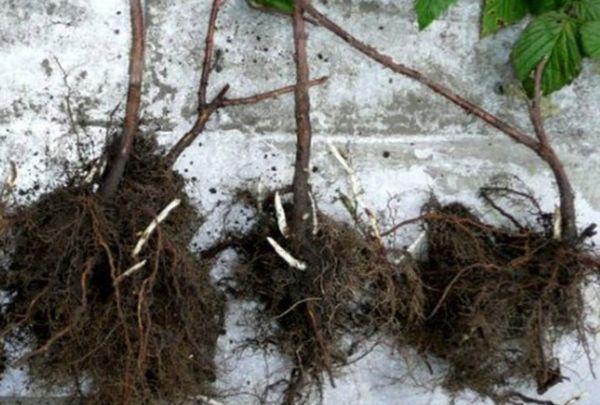
We propagate with horizontal layers
When growing horizontally, annual shoots are used. This type of breeding takes place in the spring. Next to the bush, a groove is dug with a depth of 10-15 cm.
The shoots are bent to the ground and buried in the ground. They need to be fixed in order to root. As soon as the stem begins to germinate and build up deciduous mass, it is separated from the mother bush. In this case, there may be several seedlings. This breeding method is carried out in the summer.
Germinating from seeds
Seed cultivation is not very popular among summer residents. This method is laborious, time consuming and not the most effective.This method is preferred by breeders to breed new varieties.
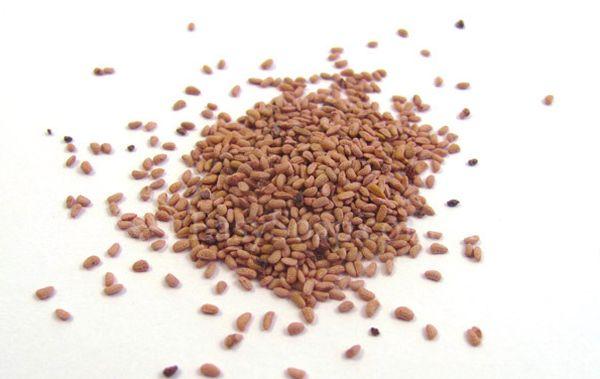
How to get raspberry seeds:
- To obtain the seed, the largest raspberries are harvested and squeezed out of juice.
- Then the juice is poured into a container together with water and filtered through cheesecloth. The procedure is repeated several times until the water becomes clear and the seeds remain at the bottom of the container.
Dry the seeds, place them in a paper envelope and refrigerate.
Stratification is carried out before sowing raspberry seeds. For this, the seeds are poured with water, the container is placed in the refrigerator for 24 hours. Then they are mixed with sand. Sand with planting material is poured into nylon stockings and removed to the cellar. The bags themselves are covered with sawdust. The seeds are stored in the cellar for about 3 months.
Planting material is planted after the temperature in the room reaches +20 degrees. Seeds are planted in containers with fertile soil. To create a greenhouse effect, the containers are covered with cling film and placed on the south windows.

The seedlings are transplanted into separate pots after they grow about 10 cm high. When warm weather is established outside, they are planted in open ground.
Tips for beginner gardeners
In order for remontant varieties of raspberries to take root faster after planting and give a rich harvest, you must follow the rules for caring for bushes:
- To make grafting more active, before planting raspberries, the soil is fertilized with mineral and organic dressings.
- For the winter, the planted bushes are covered with spruce branches or agrofibre.
- It is recommended to plant raspberries in well-lit areas and in fertile soil.
- When propagated by green cuttings, to accelerate the emergence of roots, the lower part of the cuttings is treated with growth activators for agricultural crops.
- It is undesirable to plant seedlings in the lowlands, where water accumulates and stagnates in spring.
- Young seedlings are regularly fed with mineral and organic fertilizers.
- To prepare cuttings for planting, only sharpened pruners are used. There should be no creases in the places of the cuts.
With proper care, raspberry cuttings will quickly take root in a new place, and the next year after planting they will begin to bear fruit.



